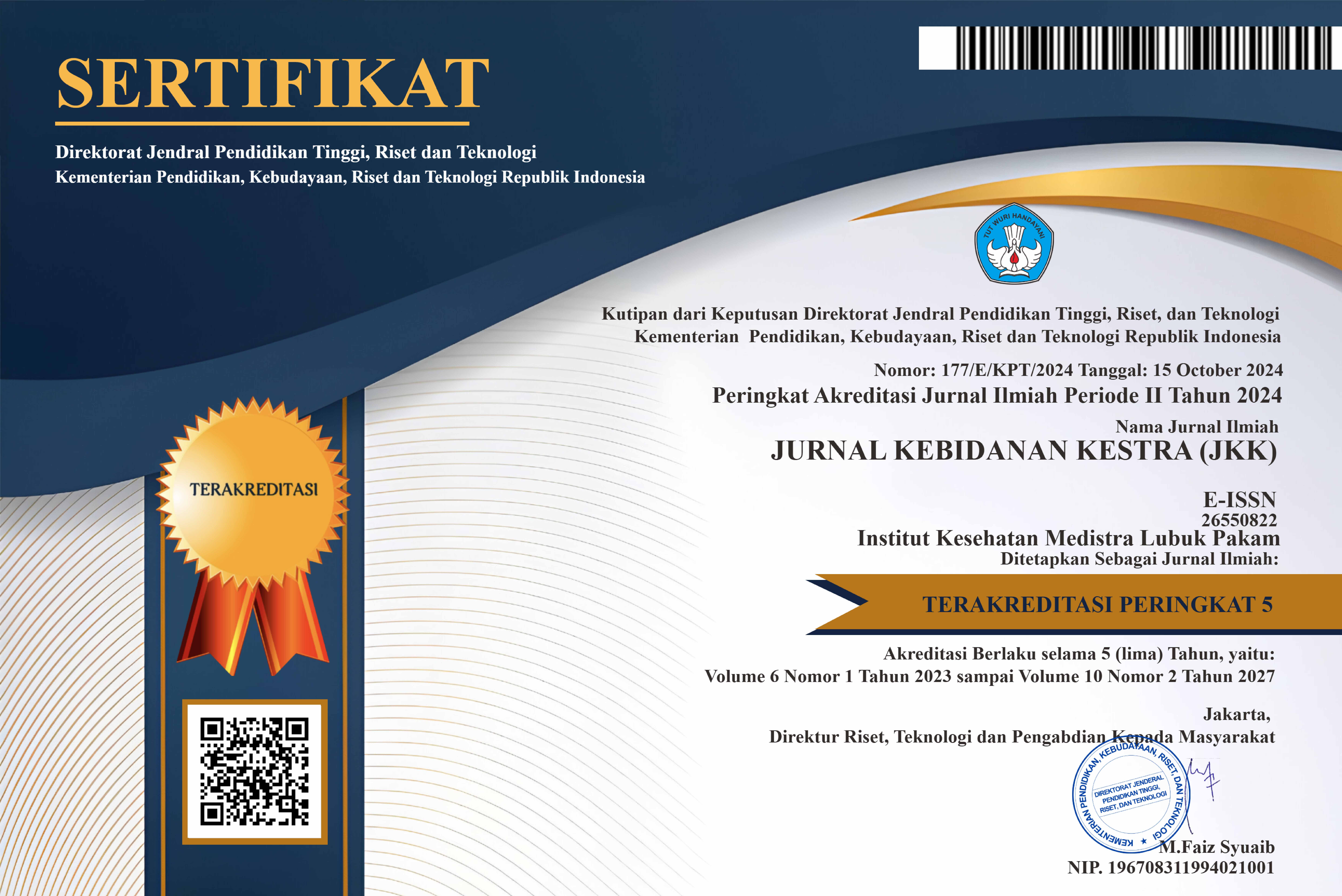The Relationship Between The Number of Children and The Distance of Pregnancy With The Nutritional Status of Toddlers In Lestari Dadi Village, Pegajahan District, Serdang Bedagai Regency Year 2022
DOI:
https://doi.org/10.35451/jkk.v5i1.1366Keywords:
child, pregnancy, toddler nutritionAbstract
Nutritional status plays an important role in determining the quality of human resources, especially children under five. Most people have the number of children under five in one family > 2 toddlers and not a few pregnancies are close together < 2 years. The distance of pregnancy and the number of children also affect the nutritional status of children under five. The research method used is analytic quantitative using a cross sectional design. The sample in this study used purposive sampling with a sample of 49 respondents and the data obtained in the study were analyzed through two stages, namely univariate to determine the description and bivariate to determine the relationship (chi square). The results showed that the number of children in the 2 category was 55.9%. The distance between pregnancies in the 2 year category was 83.7%. The nutritional status in the good nutrition category (Normal) was 69.4%. There is a relationship between the number of children and the nutritional status of children under five (p=0.043). There is a relationship between the distance of pregnancy with the nutritional status of children under five (p = 0.015). Based on the results of this study,the authors suggest to mothers who have toddlers to adjust the birth spacing and the number of toddlers owned so that the nutritional status of toddlers is good.
Downloads
References
Bitikara, (2016), Faktor- faktor yang berhubungan dengan di status gizi balita Desa Teluk Singkil Kabupaten Aceh Singkil tahun 2016, Diakses tanggal 10 Januari 2022. Dari : http://jurnal.usu.ac.id/index.php/9kre/a rticle/view/1207
Carolin, B. T., Saputri, A. R., & Silawati, V, (2020), Analisis Faktor Yang Mempengaruhi Status Gizi Balita (12-59 Bulan) Di Puskesmas Sukadiri Kabupaten Tangerang Tahun 2018. Ilmu dan Budaya, 41(66).
Chandra, A, W, (2017), Hubungan Antara Karakteristik Ibu dengan Status Gizi Balita di Kelurahan Sekaran Kecamatan Gunungpati Semarang. Doctoral dissertation. Universitas Negeri Semarang.
Dinas Kesehatan Prov. Sumut, (2019), Profil Kesehatan Indonesia 2019, Jakarta: Kemenkes RI.
Dinas Kesehatan Kabupaten Serdang Bedagai, (2021), Profil Kesehatan Indonesia 2019, Jakarta: Kemenkes RI.
Fajarina C. A, (2016), Faktor-faktor yang berhubungan dengan berat badan bayi baru lahir di Rumah Sakit Umum Daerah Sigli Kabupaten Pidie. Dari : http://180.241.122.205
Fajarina C. A, (2018), Faktor-faktor yang berhubungan dengan berat badan bayi baru lahir di Rumah Sakit Umum Daerah Sigli Kabupaten Pidie. Dari : http://180.241.122.205
Faradevi, Reni, (2011), Perbedaaan besar pengeluaran keluarga jumlah anak serta asupan energy dan protein balita antara balita kurus dan normal. Semarang : Universitas Diponegoro Program Studi Ilmu Gizi Fakultas kedokteran.
Kementrian Kesehatan RI, (2020), Pedoman Pelayanan Gizi Pada Masa taggap darurat covid-19. 44. https://covid19.go.id/storage/app/media/Materi Edukasi/2020/Mei/
pedoman- pelayanan-gizipada-masa-tanggap-darurat-pandemi-covid-19-13-05-2020.pdf# page=
&zoom=auto,-99,792.
Lutviana E, Budiono I, (2018), Prevalensi dan determinan kejadian Gizi kurang pada balita, Jurnal Kesehatan masyarakat. Diakses tanggal 13 Januari 2022. Dari : http://journal.unnes.ac.id/index.php/kesmas
Mutika W, Syamsul D. Analisis Permasalahan Status Gizi Kurang Pada Balita Di Puskesmas Teupah Selatan Kabupaten Simeuleu. Jurnal Kesehatan Global [Internet]. 2018;1(3):127–36. Available from: http://ejournal.helvetia.ac.id/index.php/jkg/article/view/3952/103
Putri, R. F., Sulastri, D., & Lestari, Y, (2015), Faktor-Faktor yang Berhubungan dengan Status Gizi Anak Balita di Wilayah Kerja Puskesmas Nanggalo Padang, Jurnal Kesehatan Andalas, 4(1).
Rahayu, (2017), Analisis Faktor-Faktor yang Berhubungan dengan Status Gizi pada Balita di Posyandu Mawar RW 05 Kelurahan Wonodri, Jurnal Kedokteran Muhammadiyah, 1(2).
Setyowati, M. & Astuti, R, (2017), Pemetaan Status gizi balita dalam mendukung keberhasilan pencapaian millenium development goals (MDGs). KEMAS: Jurnal Kesehatan Masyarakat, 10, 110-121.
Suryani, Linda (2017), Faktor Yang Mempengaruhi Status Gizi Balita Di Wilayah Kerja Puskesmas Payung Sekaki, Jomis (Journal Of Midwifery Science), 1(2), 47-53.
Widianti E, Y dan Setiyaningsih A, (2017), Hubungan jarak kelahiran dengan kejadian perdarahan post partum primer di BPS Hermin Sigit Ampel Boyolali.
WHO, (2020), Nutrition Landscape Information System (NLIS) Country Profile Indicators,.Interpretation Guide, editor. Switzerland: WHO Press.
Downloads
Published
Issue
Section
License
Copyright in each article is the property of the Author.



























